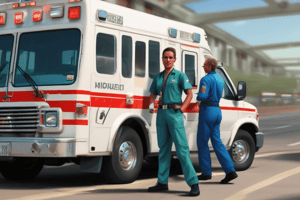Podcast
Questions and Answers
When assessing an unconscious diabetic patient, what is the primary visible difference between hyperglycemia and hypoglycemia?
When assessing an unconscious diabetic patient, what is the primary visible difference between hyperglycemia and hypoglycemia?
Rate and depth of breathing.
In a patient with sickle cell disease presenting with severe acute pain in the left upper quadrant, what should you suspect?
In a patient with sickle cell disease presenting with severe acute pain in the left upper quadrant, what should you suspect?
Her spleen is enlarged because of red blood cell engorgement.
What should you suspect for a 28-year-old female with type 1 diabetes who has been urinating excessively over the last 24 to 36 hours?
What should you suspect for a 28-year-old female with type 1 diabetes who has been urinating excessively over the last 24 to 36 hours?
She is significantly hyperglycemic.
Diabetic coma typically develops over a period of hours or days.
Diabetic coma typically develops over a period of hours or days.
What is the normal blood glucose level as measured by a glucometer?
What is the normal blood glucose level as measured by a glucometer?
What is hemoglobin responsible for?
What is hemoglobin responsible for?
How should a 75-year-old male with type 1 diabetes and chest pain be treated?
How should a 75-year-old male with type 1 diabetes and chest pain be treated?
An acute accelerated drop in the hemoglobin level occurs during a(n) __________ crisis.
An acute accelerated drop in the hemoglobin level occurs during a(n) __________ crisis.
What do Kussmaul respirations indicate?
What do Kussmaul respirations indicate?
What does being treated with factor VIII indicate?
What does being treated with factor VIII indicate?
Why do patients with uncontrolled diabetes experience polyuria?
Why do patients with uncontrolled diabetes experience polyuria?
What leads to ketone production?
What leads to ketone production?
What is a trade name for oral glucose?
What is a trade name for oral glucose?
How does insulin function in the body?
How does insulin function in the body?
What should you suspect for a 42-year-old male found unresponsive with a blood glucose level of 75 mg/dL?
What should you suspect for a 42-year-old male found unresponsive with a blood glucose level of 75 mg/dL?
Which condition is a diabetic patient at an increased risk of developing?
Which condition is a diabetic patient at an increased risk of developing?
What should you do for an unresponsive patient with type 2 diabetes who has not eaten for 24 hours?
What should you do for an unresponsive patient with type 2 diabetes who has not eaten for 24 hours?
What causes diabetic coma?
What causes diabetic coma?
What is the definitive treatment for a patient with a blood sugar reading of 300 mg/dL?
What is the definitive treatment for a patient with a blood sugar reading of 300 mg/dL?
What is another name for Glipizide, a non-insulin-type medication?
What is another name for Glipizide, a non-insulin-type medication?
What is diabetes MOST accurately defined as?
What is diabetes MOST accurately defined as?
Why do children experience hypoglycemic crisis more often?
Why do children experience hypoglycemic crisis more often?
Flashcards are hidden until you start studying
Study Notes
Diabetic Assessment and Conditions
- Unconscious diabetic patients show significant differences in breathing patterns between hyperglycemia and hypoglycemia.
- Sickle cell disease may cause splenic enlargement due to red blood cell engorgement.
- A patient with type 1 diabetes, responsive only to verbal stimuli, is likely experiencing significant hyperglycemia due to high blood sugar levels and excessive urination.
- Diabetic coma can develop gradually over several hours to days, signaling potential complications from uncontrolled diabetes.
- Normal blood glucose levels range from 80 to 120 mg/dL.
Blood Components and Functions
- Hemoglobin, located in red blood cells, is crucial for oxygen transportation.
- Kussmaul respirations indicate the body’s efforts to eliminate acids from the bloodstream.
Diabetes Complications
- Deterioration in diabetic patients can lead to conditions like heart attacks, particularly in older patients with coexisting diabetes and chest pain.
- Hemolytic crises are characterized by rapid red blood cell breakdown leading to decreases in hemoglobin levels.
- Patients experiencing uncontrolled diabetes may develop polyuria as excess glucose is filtered out by the kidneys.
Ketones and Insulin Mechanism
- Ketones are produced through fat metabolism when glucose is scarce, worsening diabetic conditions.
- Insulin plays a significant role in helping glucose enter body cells, regulating blood sugar levels effectively.
Patient Management Considerations
- Treat patients with hemophilia exhibiting unresponsiveness and irregular breath patterns as potential cases of intracranial bleeding; rapid transport is critical.
- Diabetic patients face increased risks for complications like blindness due to long-term effects of poorly controlled blood sugar levels.
- In emergencies, unresponsive patients with diabetes should have carotid pulses checked swiftly to assess life-threatening conditions.
Medication Insights
- Glutose is the trade name for oral glucose used in emergency treatment for hypoglycemia.
- Glipizide, known commercially as Glucotrol, is a non-insulin medication aiding in diabetes management.
Definition and Risk Factors
- Diabetes is fundamentally a disorder relating to carbohydrate metabolism, influencing how the body manages sugars.
- Children are at an increased risk for hypoglycemic crises due to inconsistent eating habits, necessitating careful monitoring and management.
Studying That Suits You
Use AI to generate personalized quizzes and flashcards to suit your learning preferences.




